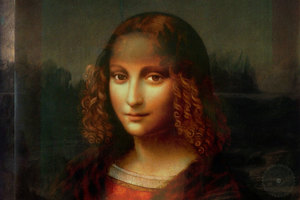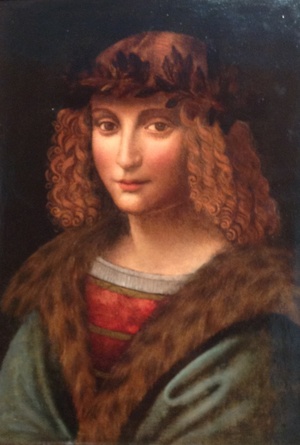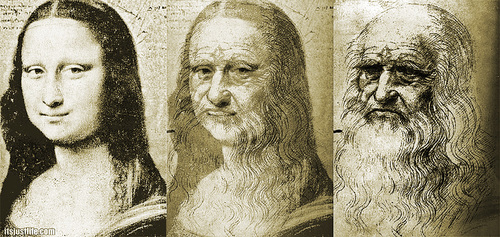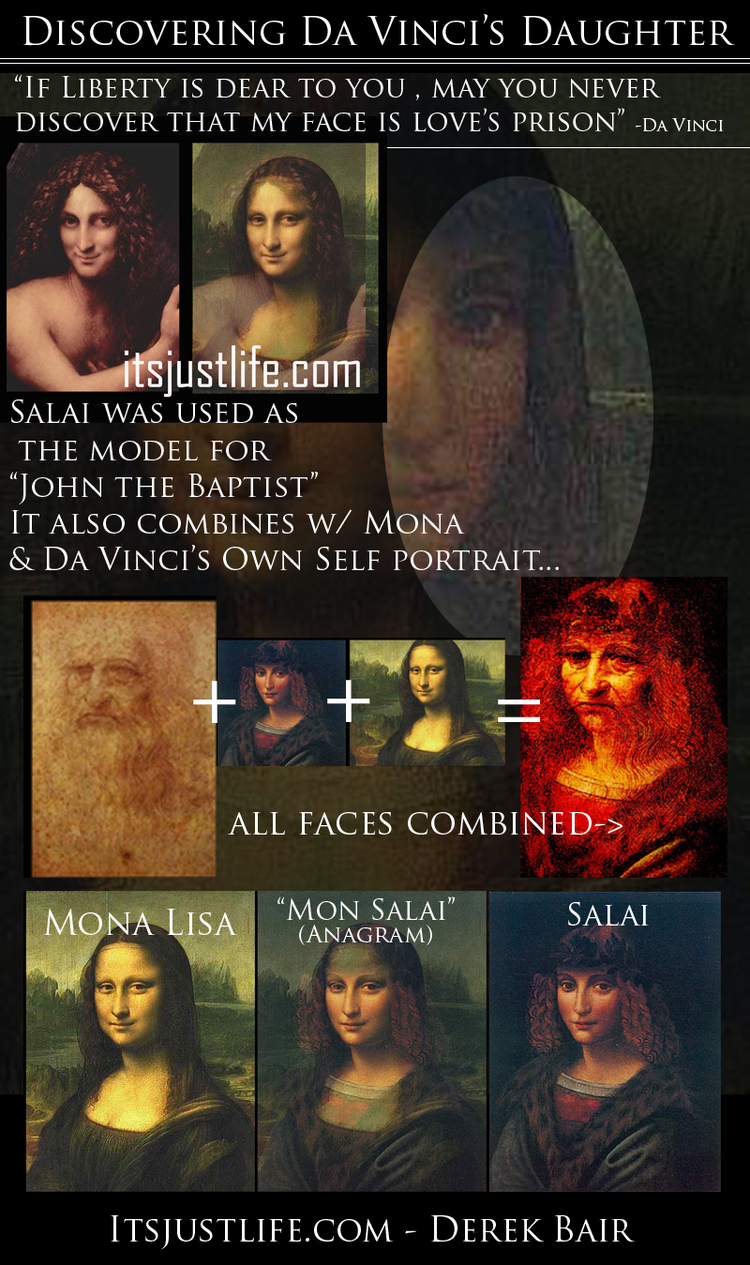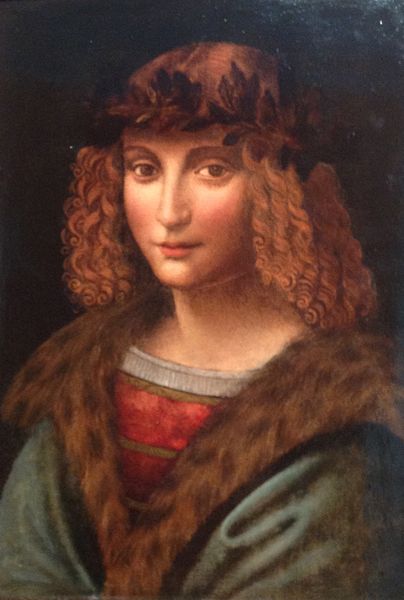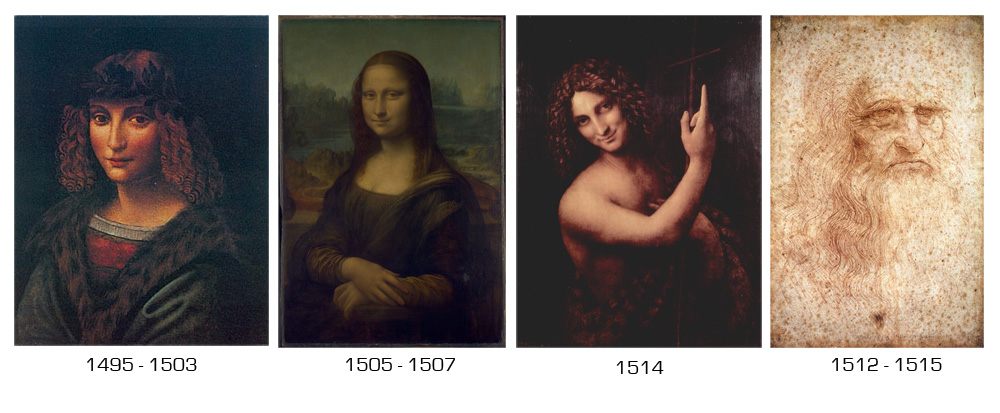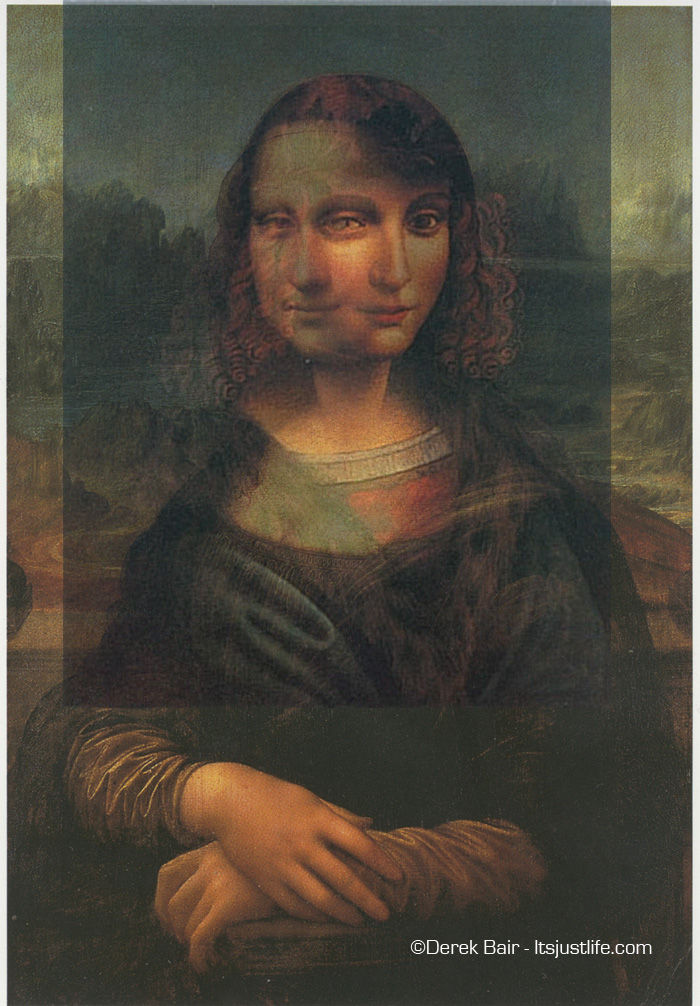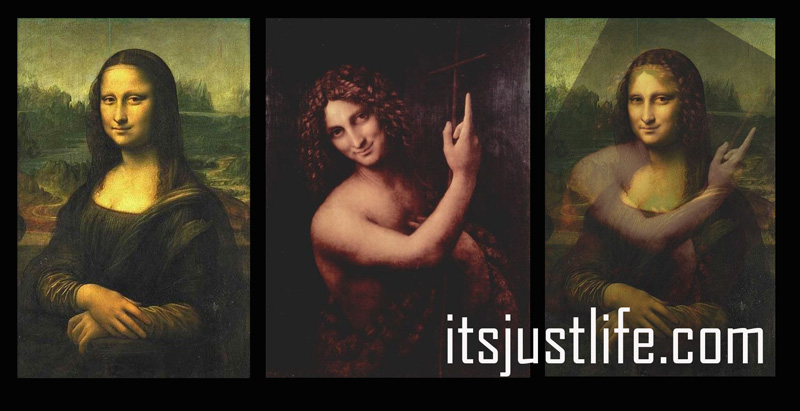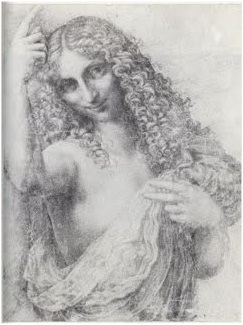Mon Salai
This is a painting of Da Vinci's pupil, assistant, and lover Salino Giacomo, or "Salai." Why is the title "Mona Lisa" an anagram for "Mon Salai" ? Why does a painting of Salai combine with the painting of Mona Lisa?
M.on Salai
The Portrait of Salai and the Mona Lisa's faces combined at 50% transparency.
"Mon Salai" is an anagram of "Mona Lisa" - what does Mon Salai mean? It means "My Salai" in French. Leonardo was known for word and title games and the Mona Lisa is no different. The reasons for her intentional mysteries and curiosities can be partly explained by the discoveries I've made over the last few years.
In my book I show that Salai was also used as a basis for the Mona Lisa - based off of a painting of Salai which was painted before the Mona Lisa being able to be purposely superimposed over each other. Salai's other name "Salino" also works as an anagram: "ona lisa." The bridge in the background of the Mona Lisa is also thought to be identified as "The Devils Bridge" Salai means "Little Devil." Another anagram of "Mona Lisa" is "M onSalai." M *Mona* does go on, Salai...
Portrait of Salai combined with the Mona Lisa
My 'discovery' being that when the two paintings are superimposed they create a "Daughter" image - both literally and metaphorically. The same idea behind two people taking pictures of their faces and combining them together to see what their child would look like.
The Mona Lisa and Leonardo's self portrait superimposing.
“Do not reveal, if freedom is dear to you, that my face is the prison of love.”
— Leonardo da Vinci
If Salai's face aligns with the Mona Lisa that means that it also aligns with Leonardo's self portrait since it also aligns with the Mona Lisa.
Since they were two men and could not have a child together they, instead, painted one. Since this was 500 years ago and they could be killed for this let alone their paintings destroyed they were forced to keep it obscure and cryptic. This accounts for secrecy and strange coincidences surrounding the Mona Lisa and a lot of other of Leonardo's works. He left behind many clues and signs to point to this that had gone largely un-noticed mostly due to his works being scattered and some not being seen by the public. With the advent of photography and the internet more of his art and notebooks have become more accessible. It was by coming in late and naively into Leonardo's world that I noticed these coincidences that I took as clues that eventually led me to putting the pieces together.
Any one of these 'coincidences' taken independently may just seem coincidental but after they keep piling up on top of each other they became part of larger story. I've spent a large portion of the last few years trying to explore alternate explanations or to play the "Derek's advocate" but it all seems to lead back to this theory, as crazy and controversial as it may be.
Since I've spent so much time picking this theory apart I've inadvertently over-looked the most obvious aspects. If this isn't just conjecture and really was Leonardo's intention then wouldn't he have left behind evidence for it?
Yes, but because of the sensitive nature of this he couldn't state it openly and had to literally "cover it up." In my sub-quest to dis-prove this I explored an even more mysterious enigma - what is true? How much evidence was required before this was "proven" to be true? I guess I didn't realize until looking back that I already had enough evidence when I first realized that the Mona Lisa and Salai's face combined. I was well versed enough in digital media and photography to know that you couldn't get two faces to do that accidentally or coincidentally. I even tried to get two faces to do the same thing by purposely taking their photograph with the intention of the faces aligning and couldn't get it as aligned as these two paintings are. That alone is enough evidence for many and especially for those who take the time to consider the intricacies that would go into this being able to happen to two different paintings. There is no denying that the two faces are connected. What that connection is - is another story which I explore in annoying detail in my book.
This shows the portrait of Salai (c.1495-1500) being superimposed over the Mona Lisa (c. 1500-1519)
“The lover is moved by the beloved object as the senses are by sensual objects; and they unite and become one and the same thing. The work is the first thing born of this union; if the thing loved is base the lover becomes base.”
— Leonardo da Vinci
An article about this from 2006 can be read here:
The detail from a page of Leonardo's notebooks shows he thought of the idea of superimposing faces. This page has the following cryptic passage with it which I think alludes to the faces being combined. A further explanation will be presented in it's chapter in my book.
"Truth – The Sun
Falsehood – A mask
Innocence
Malignity
Fire destroys falsehood – that is sophistry – and restores truth, driving out darkness.
Fire may be represented as the destroyed of all sophistry and as the image and demonstration of truth: because it is light and drives out darkness wich conceals all essence or subtle things..
Truth
Fire destroys all sophistry – that is deceit – and maintains truth alone – that is, gold. Truth at last cannot be hidden. Dissimulation is of no avail. Dissimulation is to no purpose before so great a judge.
Falsehood puts on a mask. Nothing is hidden under the sun. Fire is to represent truth because it destroys all sophistry and here lies: and the mask is for lying and falsehood which conceal truth.” – Leonardo da Vinci.

